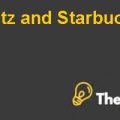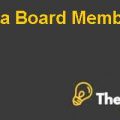Globalizing the Cost of Capital & Capital Budgeting at AES Case Study Solution
Sovereign Spread
Country-specific market risk was also accounted for WACC calculation. Sovereign spread is simply difference between return of US Treasury bonds and return of local government bonds.
WACC Adjustments for Unsystematic Risks
AES’s management believed that there were also some risks which were project specific and unsystematic i.e. diversifiable. For that purpose they used approach that included two steps. First, seven categories of risks were identified regarding each project. Ranking was given on the basis of ability to anticipate and mitigate risks.
Second, grading was given on the basis of exposure to these seven categories.Then adjustment to initial cost of capital was calculated through these risk scores which are business specific.
As business-specific risk score for Lal Pir Project based in Pakistan is 1.425 and ranking given as 1 which means it would also add 5%. It would be calculated as 7.125% (1.425*5%). In this way risk adjusted WACC for projects based in Pakistan would be 7.125%, more value and is calculated as 23.1% (15.97%+7.125%). So the discount rate that AES would use around the world would be 15.97%+ adjustment for unsystematic risk. That adjustment value would depend on the country in which the project takes place.
Evaluation of the Proposed New Methodology
A traditional approach of CAPM and WACC for evaluating projects were generating unreasonable results in this scenario. This new methodology incorporates both systematic and unsystematic risks which also include sovereign risks and specific risks that are related to specific projects.
The value of Lal Pir Project based in Pakistan would be worth $276.32 billion. However, if this project was based in the US then its worth would’ve been $731 billion, because of less value of WACC as compared to Pakistan. The valuation is based on 20 years i.e. from 2004 to 2023. The adjusted WACC for the value of Lal Pir Project based in Pakistan is 23.1% which incorporates both systematic and unsystematic risks.
Exhibits
Exhibit 1
| LAL Project Based in Pakistan | |
| Business Specific Risk | 1.425 |
| Tax rate | 23% |
| EBIT Coverage | 3 |
| Sovereign Spread | 10% |
| Unlevered Beta | 0.253 |
| Premium | 7% |
| Debt to Cap | 35% |
| Default Spread | 4% |
| Risk Free Rate | 5% |
| E/V % Financed Through Equity | 65% |
| D/V % Financed Through Debt | 35% |
| Business Specific Risk % | 5% |
| No. of Years | 20 |
Exhibit 2
| Weighted Average Cost of Capital (Pakistan) | |
| Levered Beta | 0.39 |
| Cost of Equity | 7.23% |
| Cost of Debt | 8% |
| Risk Adjusted Cost of Equity | 17% |
| Risk Adjusted Cost of Debt | 18% |
| WACC | 15.97% |
| Adjustment for Unsystematic Risk | 7.13% |
| Risk Adjusted WACC | 23.10% |
Exhibit 3
| LAL Project Based in US | |
| Tax rate | 37.50% |
| EBIT Coverage | 3 |
| Sovereign Spread | 0 |
| Unlevered Beta | 0.253 |
| Premium | 7% |
| Debt to Cap | 39.50% |
| Default Spread | 3.57% |
| Risk Free Rate | 4.50% |
| E/V % Financed Through Equity | 60.50% |
| D/V % Financed Through Debt | 39.50% |
| No. of Years | 20 |
Exhibit 4
| Weighted Average Cost of Capital (US) | |
| Levered Beta | 0.42 |
| Cost of Equity | 7% |
| Cost of Debt | 8.07% |
| Risk Adjusted Cost of Equity | 7% |
| Risk Adjusted Cost of Debt | 8.07% |
| WACC | 6.49% |
Exhibit 5
| Year | Cash Flows |
| 2004 | 63.2 |
| 2005 | 63.6 |
| 2006 | 64 |
| 2007 | 64.4 |
| 2008 | 64.8 |
| 2009 | 65.2 |
| 2010 | 65.7 |
| 2011 | 66.1 |
| 2012 | 66.5 |
| 2013 | 66.9 |
| 2014 | 67.3 |
| 2015 | 67.7 |
| 2016 | 68.2 |
| 2017 | 68.6 |
| 2018 | 69 |
| 2019 | 69.4 |
| 2020 | 69.8 |
| 2021 | 70.3 |
| 2022 | 70.7 |
| 2023 | 71.1 |
| Value of Project in Pakistan | $276.32 |
| Value of Project in US | $731.09 |
This is just a sample partical work. Please place the order on the website to get your own originally done case solution.













